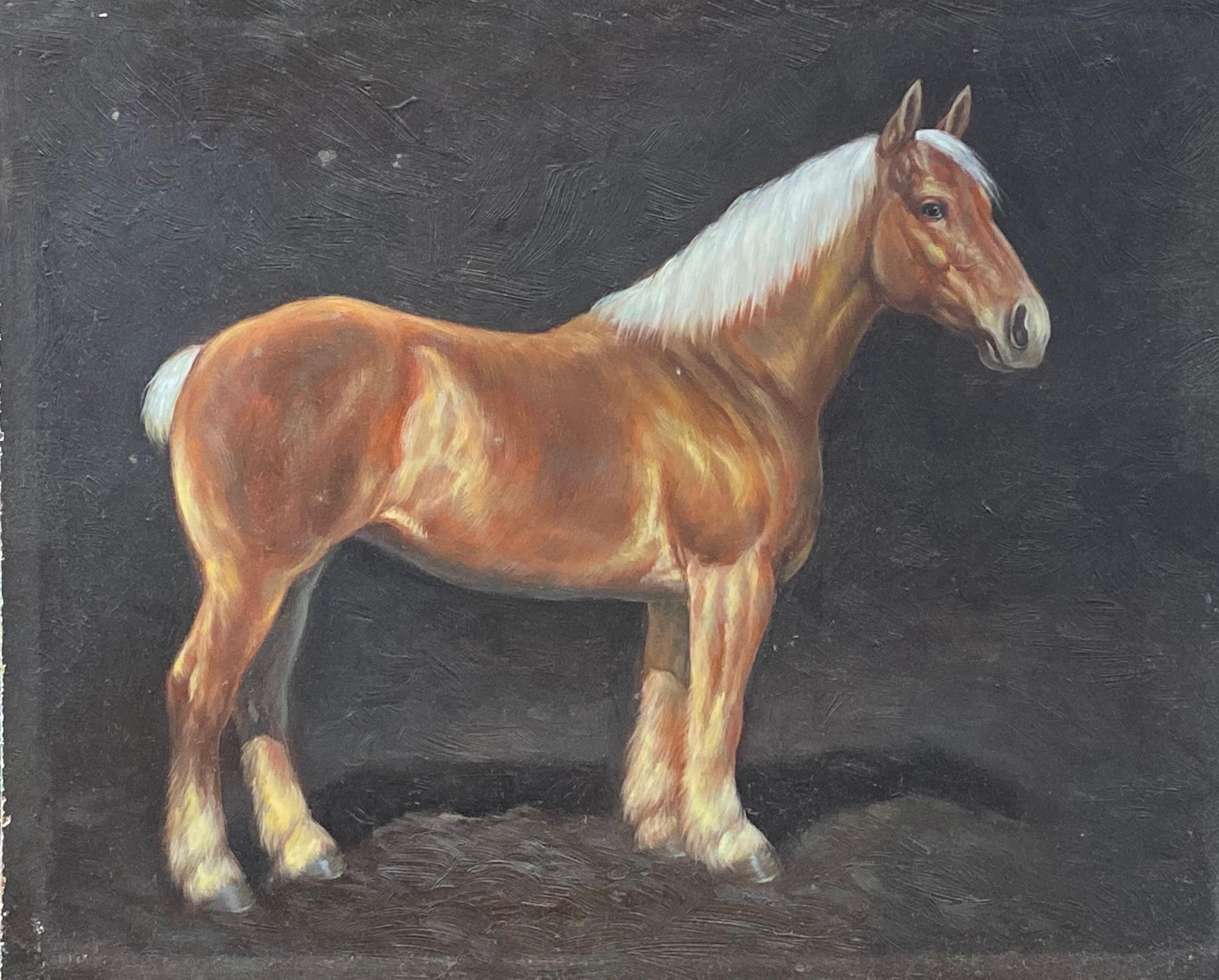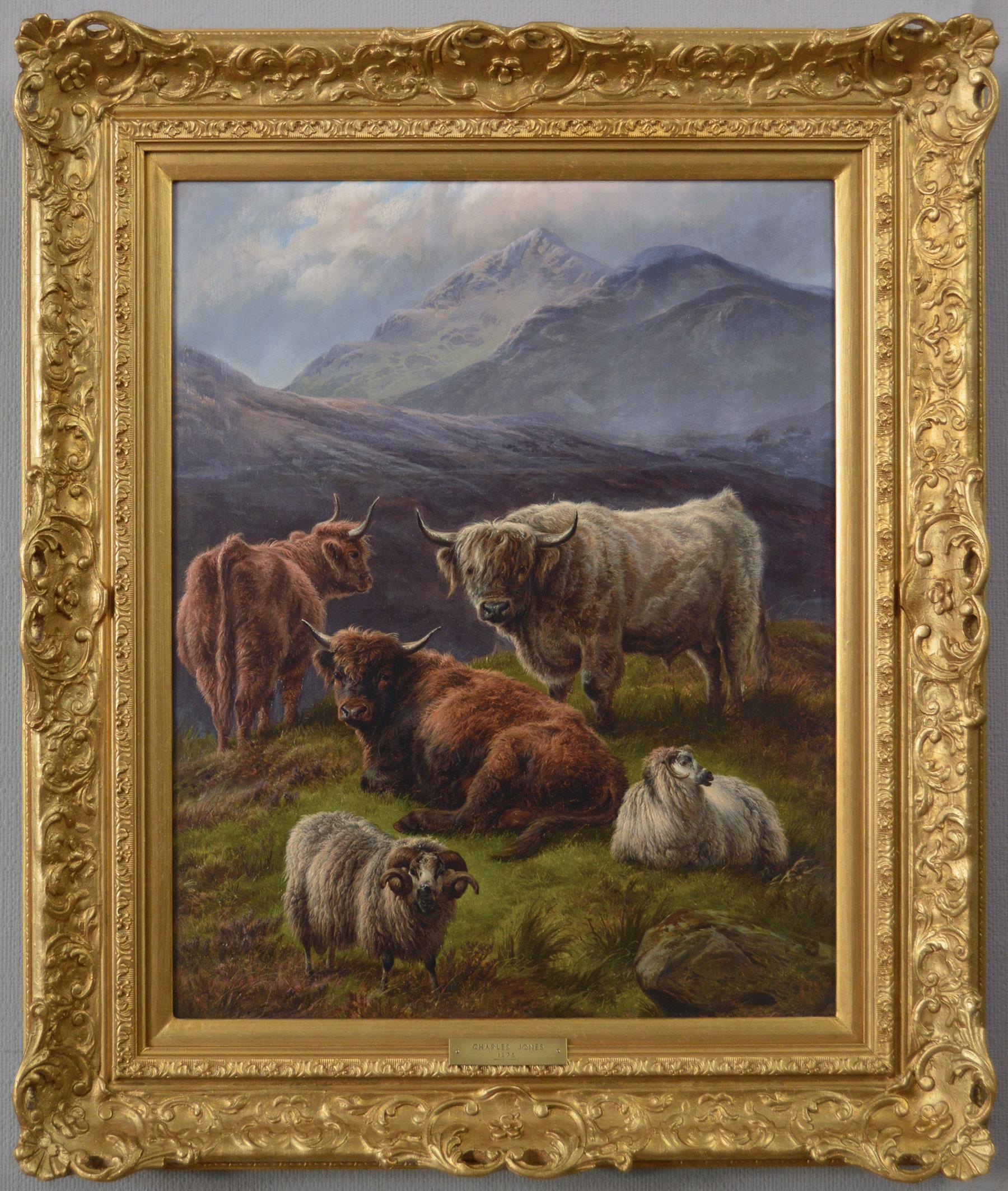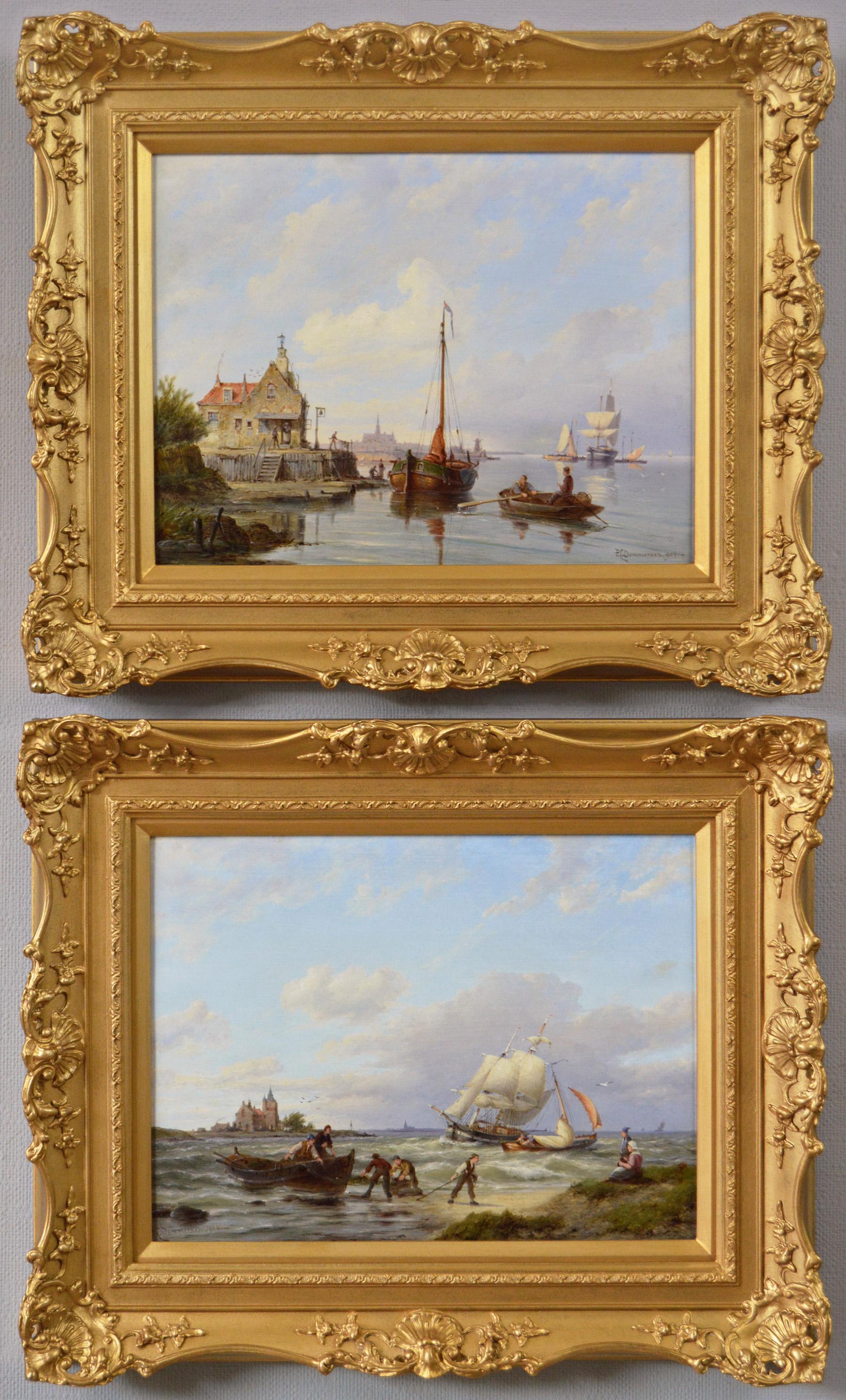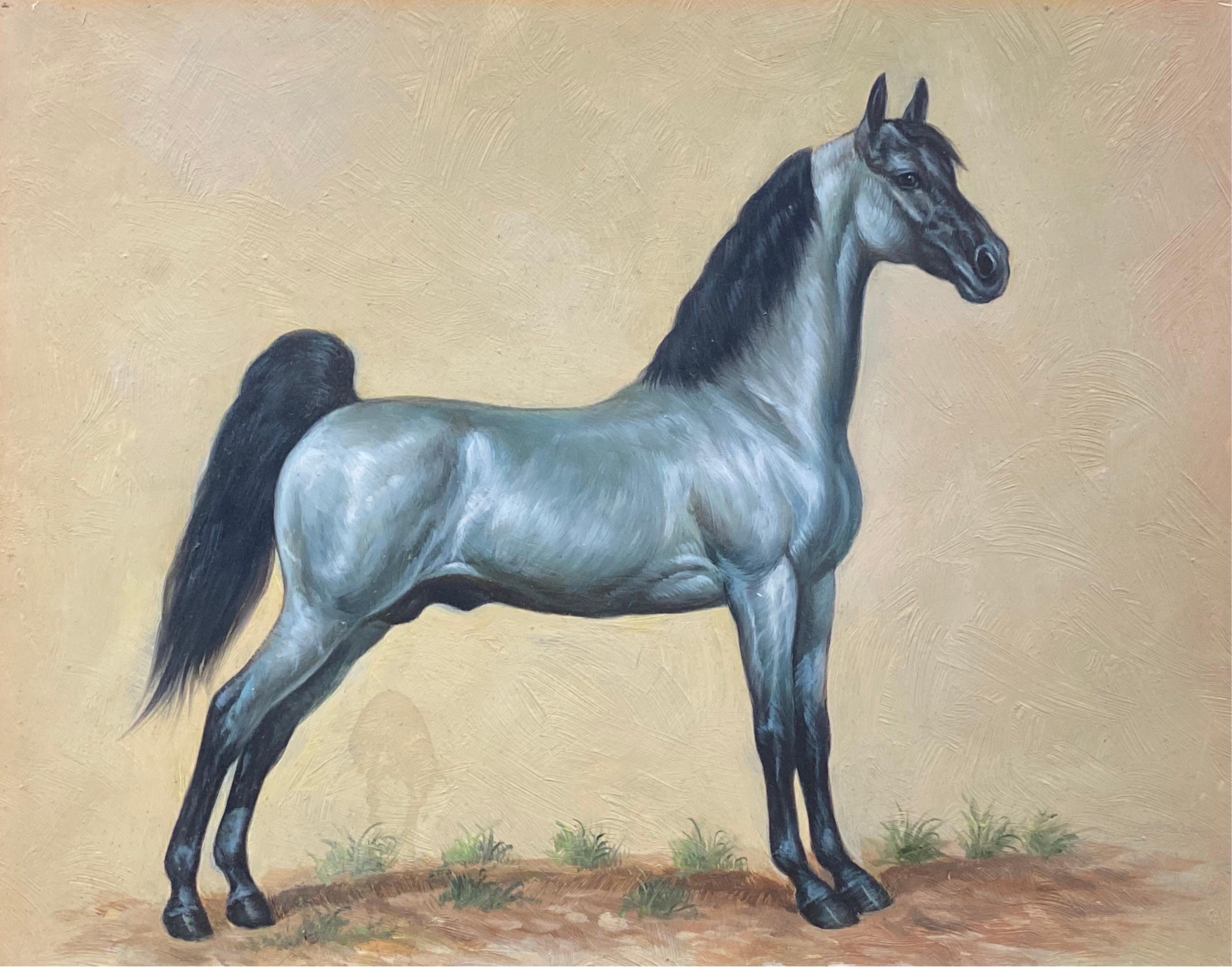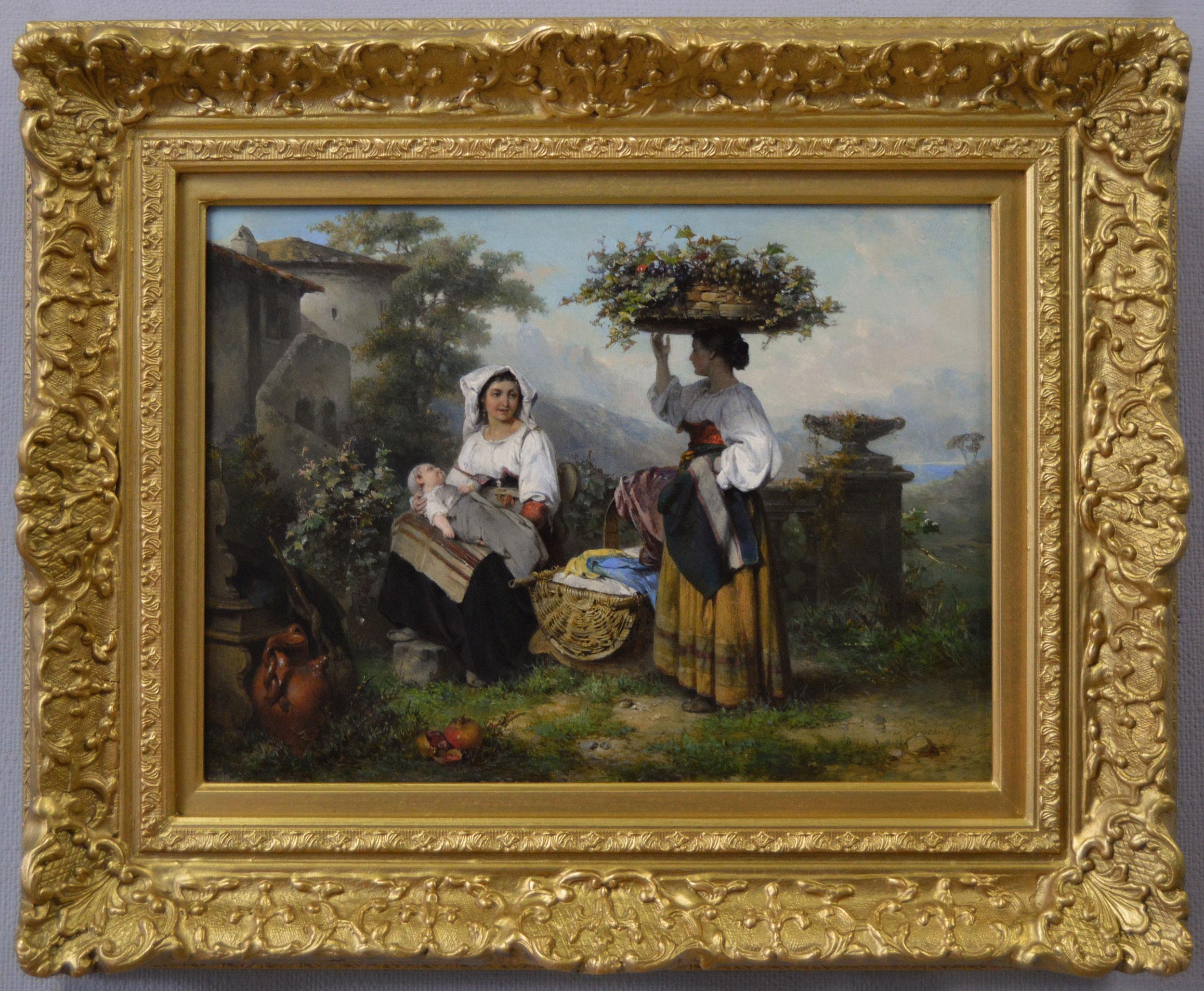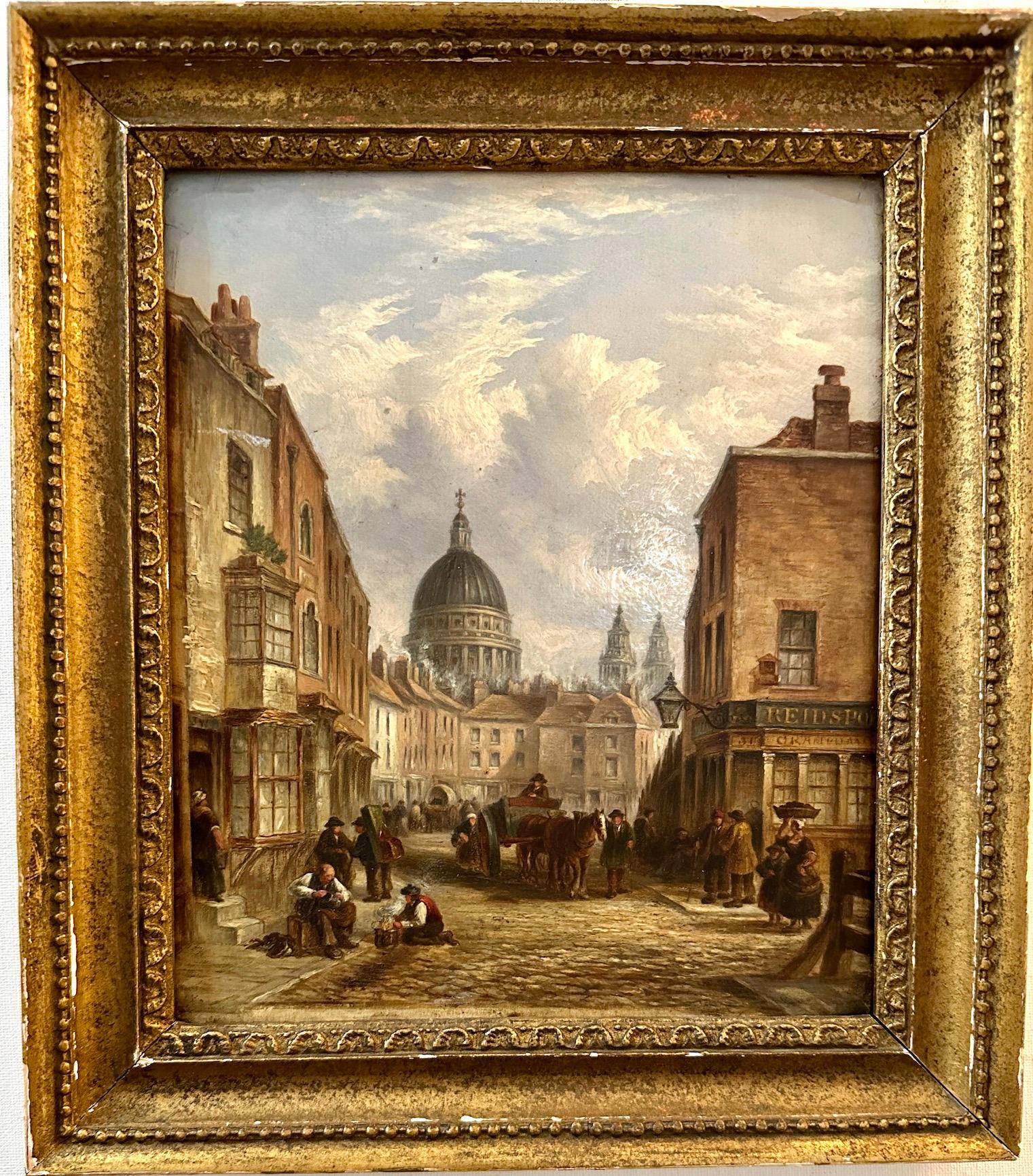Items Similar to Scalby Road, Scarborough, Moonlight Oil Painting, Grimshaw, 1874
Want more images or videos?
Request additional images or videos from the seller
1 of 2
John Atkinson GrimshawScalby Road, Scarborough, Moonlight Oil Painting, Grimshaw, 18741874
1874
About the Item
Oil on panel, signed and dated '1874' bottom left and entitled on reverse
Image size: 14 x 9 inches (35.5 x 22.75 cm)
Hand made gilt frame
Grimshaw's popularity, both in his lifetime and again today, was based on the evocative and atmospheric ‘moonlight’ paintings, such as this one, which he perfected during his Scarborough years. Indeed, four typical examples of Atkinson Grimshaw’s Scarborough ‘moonlight’ paintings are in the permanent collection at Scarborough Art Gallery. Grimshaw's long association with Scarborough began in the mid-1870s, when the artist rented a house in the town - which he named 'Castle-by-the-sea' after the Henry Longfellow poem. Scalby Road, the location of this work, was only an hour away from Grimshaw's home on foot. Unfortunately, in 1879 Grimshaw suffered a serious financial disaster and have to leave his beloved Scarborough and move away from the area.
John Atkinson Grimshaw
John Atkinson Grimshaw was born in Leeds, the son of an ex-policeman. Grimshaw first took up painting while he was employed as a clerk for the Great Northern Railway and by 1861, he had abandoned his job in order to devote all his time to becoming an artist. In his early work, he was influenced by John Ruskin’s creed of ‘truth to nature’ and adopted the detailed Pre-Raphaelite technique of the Leeds painter, John William Inchbold. He was also fascinated by the relatively new art of photography and may have used a camera obscura in developing his compositions.
Towards 1865, Grimshaw painted many urban scenes in which moonlight and shadows were the most striking features. The towns and docks that he painted most frequently were Glasgow, Liverpool, Leeds, Scarborough, Whitby and London. These works have become his best known although he also painted landscapes, portraits, interior scenes, fairy pictures and neo-classical subjects. Grimshaw painted mostly for private patrons. He exhibited five works at the Royal Academy in 1874, 1880, 1885 and 1886. He also exhibited at Sir Coutts Lindsay’s Grosvenor Gallery in 1885.
By 1870, Grimshaw had become successful enough to move to Knostrop Old Hall, a seventeenth century mansion about two miles from the centre of Leeds, which featured in many of his paintings. He rented another home near Scarborough which he called ‘The Castle by the Sea’, towards 1876. Grimshaw suffered a serious financial disaster in 1879 and had to leave his house at Scarborough. He moved to London from 1885-87 and rented a studio in Chelsea, leaving his family at Knostrop. He returned to Knostrop, where he died in 1893.
In 1858 at the age of 24 he married his cousin Frances Theodosia Hubbarde. Several of his children, Arthur Grimshaw (1864-1913), Louis H Grimshaw (1870-1944), Wilfred Grimshaw (1871-1937) and Elaine Grimshaw (1877-1970), became painters.
Museums and Galleries
Tate Britain, London, Bradford City Art Gallery, the Shipley Art Gallery, Gateshead, the Gloucester Museum and Art Gallery, the Bankfield Museum, Halifax, the Harrogate Museums and Art Gallery, the Ferens Art Gallery, Kingston-upon-Hull, the Leeds City Art Gallery, the Huddersfield Art Gallery, Kirklees Metropolitan Council, the Harris Art Gallery, Preston, the Walker Art Gallery, Liverpool, the Guildhall Art Gallery, the Scarborough Art Gallery, the Wakefield Art Gallery and Museums, the Pannett Gallery, Whitby, the Musée des Beaux-Arts, Brest, France, the Wadsworth Atheneum, Hartford, Connecticut, the Nelson-Atkins Gallery, Kansas City, Missouri, the Minneapolis Institute of Arts, Minneapolis, Minnesota, the Yale Centre for British Art, New Haven, Connecticut, the Museum of Art, New Orleans, Louisiana, the Rhode Island School of Design, Providence, Rhode Island in the United States, the Shepparton Art Centre, Welsford, Victoria, Australia.
- Creator:John Atkinson Grimshaw (1836-1893, British)
- Creation Year:1874
- Dimensions:Height: 9 in (22.86 cm)Width: 14 in (35.56 cm)
- Medium:
- Movement & Style:
- Period:
- Condition:
- Gallery Location:London, GB
- Reference Number:1stDibs: LU52414215142
About the Seller
5.0
Vetted Seller
These experienced sellers undergo a comprehensive evaluation by our team of in-house experts.
Established in 2007
1stDibs seller since 2014
64 sales on 1stDibs
Typical response time: 2 hours
- ShippingRetrieving quote...Ships From: London, United Kingdom
- Return PolicyA return for this item may be initiated within 14 days of delivery.
More From This SellerView All
- The River Thames at Twickenham, 19th Century English Oil paintingLocated in London, GBOil on panel Image size: 11 3/4 x 16 inches (30 x 40.5 cm) Original gilt frame, with old labels verso William Havell Havell was the son of a Reading drawing-master, and he partici...Category
19th Century Victorian Landscape Paintings
MaterialsOil, Panel
- Turkish Scene, 19th Century British School VictorianLocated in London, GBBritish School 19th Century Turkish Scene Oil on board Image size: 13 ½ x 10 ½ inchesCategory
19th Century Victorian Landscape Paintings
MaterialsBoard, Oil
- The WoodcutterBy Alfred EastLocated in London, GBAlfred East The Wood Cutter Oil on board Signed lower right and titled on back Image size: 10 1/4 x 15 inches (26 x 37.5 cm) Carved gilt frame This romantic landscape by East, certainly shows the influence that the Barbizon school had on his work. The Barbizon school were drawn together by their passion and desire to elevate landscape painting as a response to the Academic elevation of historical and mythological themes. Here, East truly revels in the beauty of the English landscape but also captures the mood of the time in which there was a growing concern at the rapidity of social change and its impact upon the countryside. East regularly painted the Cotswolds from the early 1890s until the end of his life - it is probable that this scenes depicts that part of the country. He focused principally on the area around Upper Swell, which he referred to as 'Over Swell', hoping to avoid the village becoming a focus for visitors seeking out the views that he portrayed. East adopted a well established three-stage-technique that made great use of the under-painting, a second layer concerned with the correction of values, and a final stage for the addition of details; all painted with lean oil paint. As can be seen in the work, during this process East practically repainted the entire canvas after the first layer and then proceeded to pick out isolated sections that required further reworking and detail. Provenance Pelter Sands Gallery Bristol, 1975 Exhibition of Twentieth Century British Painting. This work was part of Andrew Vicari...Category
Late 19th Century Victorian Landscape Paintings
MaterialsBoard, Oil
- Knole House, English School 19th Century Country House Landscape OilLocated in London, GBEnglish School 19th Century Knole House Oil on canvas Image size: 22 ½ x 35 ½ inches Gilt frame This is not only a very beautiful work of art but also a v...Category
1850s Victorian Landscape Paintings
MaterialsOil
- The New Teacher, 19th Century Victorian Interior OilLocated in London, GBGeorge Bernard ONeil 1828-1917 Oil on canvas, signed & dated (18)76 lower right Image size: 22 ½ x 17 inches Original frame The painting depicts the arrival of the new teacher, a curious pupil peeps around a door to see her, while her friends look through the open door to the classroom to catch a glimpse. The artist has gone to great lengths with the painting, such as the highly detailed Dutch tiles on the bottom right of the picture or the window above the door in the background. O'Neil often painted works with several doorways leading off and giving a sense of depth to the work. The use of light and shadow is also cleverly depicted across the work, one light source arrives from where the viewer stands filling the room and the new teacher with light, while the other window above the door in the background also gives a warm glow. George Bernard O'Neill was born on 17th July 1828 in Dublin the ninth of fifteen children of Bernard and Sarah O...Category
1870s Victorian Landscape Paintings
MaterialsOil
- David with the Head of Goliath, 19th Century Victorian OilBy John Rogers HerbertLocated in London, GBJohn Rogers Herbert RA 1810- 1890 Oil on canvas, dated '1850' lower right on sword strap Image size: 33 ½ x 23 ½ inches Gilt Watts frame This striking painting, depicts David as a y...Category
1850s Victorian Figurative Paintings
MaterialsOil
You May Also Like
- Fine Equestrian Horse Portrait British Oil Painting - Horse standingBy British Sporting ArtLocated in Cirencester, GloucestershirePortrait of a Horse British School, 20th century oil painting on panel, unframed paintings size: 8 x 10 inches condition: excellent provenance: from a private collection here in England A very fine equestrian portrait of this horse. Painted with tremendous detail and finesse, the horse is accentuated against its clear background - a technique enjoyed many George Stubbs in the 18th century and Francis...Category
20th Century Victorian Animal Paintings
MaterialsPanel, Oil
- 19th Century landscape oil painting of cattle & sheep in the HighlandsBy Charles Jones (b.1836)Located in Moreton-In-Marsh, GloucestershireCharles Jones British, (1836-1892) Cattle & Sheep in the Scottish Highlands Oil on panel, signed with monogram & dated (18)75, further inscribed verso Image size: 19.75 inches x 15.75 inches Size including frame: 26.75 inches x 22.75 inches A dramatic Scottish landscape painting of Highland Cattle and Sheep by Charles ‘Sheep’ Jones...Category
19th Century Victorian Animal Paintings
MaterialsOil, Panel
- Pair of seascape oil paintings of fishing boats by a Dutch shoreBy Pieter Cornelis DommersenLocated in Moreton-In-Marsh, Gloucestershire**PLEASE NOTE: EACH PAINTING INCLUDING THE FRAME MEASURES 18.5 INCHES X 22.5 INCHES** Pieter Cornelis Dommersen Dutch, (1833-1918) Goeser Veerhuis with Goes in the Distance & Elburg on the Zuiderzee Oil on panel, pair, both signed & dated 1904 with wax seals verso Image size: 11.5 inches x 15.5 inches (each) Size including frame: 18.5 inches x 22.5 inches (each) A wonderful pair of seascape paintings by Pieter Cornelis Dommersen. The first painting depicts the Goeser Veerhuis or Goes Ferry House on the left with the Dutch town of Goes in the distance. The ferry house was a popular landing stage for barges and fishing boats. Goes church, with its distinctive spire can be seen in the far distance. The second painting is of Elburg, a fishing port on the east shore of the Zuiderzee in the Dutch province of Gelderland. Dommersen often returned to these areas to paint when he travelled back to the Netherlands and these fine examples were most likely painted on one of these trips. Pieter Cornelis Dommersen was born Pieter Cornelis Dommershuizen or Dommerhershuisen on 6 December, 1833 in Utrecht, Holland. Little is known about his father and he appears to have been brought up solely by his mother Cornelia into an artistic family. His younger brother was the artist Cornelis Christian...Category
19th Century Victorian Landscape Paintings
MaterialsPanel, Oil
- Fine Equestrian Horse Portrait British Oil Painting - Horse standingBy British Sporting ArtLocated in Cirencester, GloucestershirePortrait of a Horse British School, 20th century oil painting on panel, unframed paintings size: 8 x 10 inches condition: excellent provenance: from a private collection here in England A very fine equestrian portrait of this horse. Painted with tremendous detail and finesse, the horse is accentuated against its clear background - a technique enjoyed many George Stubbs in the 18th century and Francis...Category
20th Century Victorian Animal Paintings
MaterialsPanel, Oil
- 19th Century genre landscape oil painting of two Italian women near a vineyardLocated in Moreton-In-Marsh, GloucestershireKarel Frans Philippeau Dutch, (1825-1897) Home from the Vineyard Oil on panel, signed & dated 1867 with old label verso Image size: 11.25 inche...Category
19th Century Victorian Figurative Paintings
MaterialsOil, Panel
- 19th century City view of London from Fleet Street with St.Pauls, shops figuresLocated in Woodbury, CTArcher was born at Newcastle-upon-Tyne, in 1808. In 1820 he went to London, and became a pupil of John Scott, a noted engraver of animals. His apprenticeship was cut short when Scott became ill, and he returned to Newcastle. There, in collaboration with William Collard he etched a series of large plates of Fountains Abbey, after drawings by John Wilson Carmichael, and on his own produced several plates for Mackenzie's History of Durham. He then moved to Edinburgh, where he made a collection of drawings of the ancient buildings and streets of the city. In about 1830 he returned to London, and entered the studio of the engravers William and Edward Finden, who were then working on illustrations for the annuals and such publications as their Bible Illustrations, and The Ports and Harbours of Great Britain. After a few years the market for this kind of illustration declined, and Archer had to find less renumerative work engraving plates for the New Sporting Magazine. Having been elected a member of the New Society of Painters in Water Colours, he produced a series of drawings of St. Mary Overy, previous to its restoration, and of Lambeth Palace. Having accumulated more than one hundred drawings of London...Category
1840s Victorian Landscape Paintings
MaterialsOil, Wood Panel
